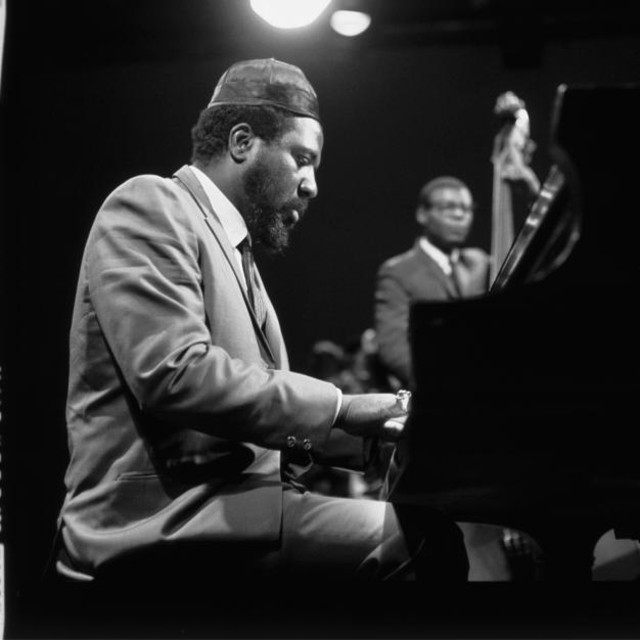Thelonious Monk stands as a colossus in the world of jazz, known for his idiosyncratic style, innovative compositions, and profound influence on the genre. His music, often characterized by dissonant harmonies and angular melodies, challenged and expanded the boundaries of jazz. Here, we explore ten of his most essential and influential works, each representing a unique facet of his genius.
1. ‘Round Midnight
One of Monk’s most famous compositions, “‘Round Midnight” is a quintessential jazz standard and a staple of the genre. Written in 1944, the piece is renowned for its haunting melody and complex chord progressions. Its melancholic beauty has attracted countless jazz musicians, resulting in numerous interpretations by artists such as Miles Davis, Cootie Williams, and Dizzy Gillespie. Monk’s own recordings of “‘Round Midnight” showcase his emotive playing and inventive harmonic sense.
2. Blue Monk
“Blue Monk” is a 12-bar blues that distills Monk’s approach to the blues with its distinctive, playful yet sophisticated melody. First recorded in 1954, the tune’s simplicity belies its deep emotional resonance and has made it a favorite among jazz musicians. Its structure allows for extensive improvisation, making it a fixture in jazz jam sessions and an accessible introduction to Monk’s oeuvre.
3. Straight, No Chaser
“Straight, No Chaser” is another blues composition that highlights Monk’s ability to create compelling, rhythmic grooves. Introduced in 1951, its catchy riff and straightforward form have made it a jazz classic. Monk’s original recordings feature his characteristic rhythmic drive and inventive phrasing, providing a masterclass in how to turn a simple idea into a profound musical statement.
4. Epistrophy
Co-written with drummer Kenny Clarke, “Epistrophy” is a defining example of Monk’s avant-garde tendencies. This 1941 composition is marked by its unconventional structure and syncopated rhythm, pushing the boundaries of jazz at the time. The tune’s title reflects Monk’s penchant for wordplay, combining “epistrophe” (a rhetorical term for repetition) and “epistrophe” (the Greek word for “turning around”). The piece’s dissonant chords and off-kilter melodies embody Monk’s experimental spirit.
5. Monk’s Mood
“Monk’s Mood” is a ballad that reveals the more introspective and lyrical side of Monk’s artistry. First recorded in 1947, the piece features a beautiful, meandering melody that unfolds over a lush harmonic backdrop. Its meditative quality and subtle emotional depth have made it a favorite among listeners who appreciate the softer, more contemplative aspects of Monk’s music.
6. Well, You Needn’t
“Well, You Needn’t” is a bebop classic that showcases Monk’s quirky sense of humor and harmonic ingenuity. Composed in 1944, the piece’s angular melody and rapid chord changes provide a lively framework for improvisation. Its playful nature and challenging structure have inspired many jazz musicians to explore its intricacies, making it a beloved part of the jazz repertoire.
7. Ruby, My Dear
“Ruby, My Dear” is one of Monk’s most tender and romantic compositions, dedicated to his first love, Ruby Richardson. Written in 1947, the ballad features a lush, melancholic melody that contrasts with Monk’s more abstract works. Its emotional depth and lyrical beauty have made it a favorite among jazz vocalists and instrumentalists alike, providing a window into the softer side of Monk’s genius.
8. In Walked Bud
“In Walked Bud” is a tribute to Monk’s friend and fellow pianist Bud Powell. Composed in 1947, the piece captures the energetic spirit of bebop with its upbeat tempo and intricate melody. The tune’s infectious rhythm and clever chord changes reflect Monk’s admiration for Powell’s virtuosity and have made it a popular choice for jazz musicians seeking to honor the bebop tradition.
9. Crepuscule with Nellie
Dedicated to Monk’s wife, Nellie, “Crepuscule with Nellie” is a poignant and deeply personal composition. Written in 1957 during a difficult period in Monk’s life, the piece’s title refers to the twilight (crepuscule) and evokes a sense of intimate reflection. The composition’s rich harmonies and lyrical lines reveal Monk’s ability to convey profound emotion through his music.
10. Evidence
Originally titled “Justice,” “Evidence” is a striking example of Monk’s innovative approach to rhythm and harmony. Composed in 1948, the piece is built around a simple yet compelling rhythmic motif that serves as the basis for complex improvisation. Its offbeat phrasing and challenging chord changes epitomize Monk’s unique style, making it a favorite among musicians who relish its rhythmic and harmonic challenges.
Conclusion
Thelonious Monk’s contributions to jazz are immeasurable, with each of these compositions offering a glimpse into his extraordinary musical vision. Whether exploring the haunting beauty of “‘Round Midnight” or the playful energy of “Well, You Needn’t,” listeners can appreciate Monk’s ability to blend complexity with accessibility, creating music that continues to inspire and captivate audiences worldwide.


No responses yet